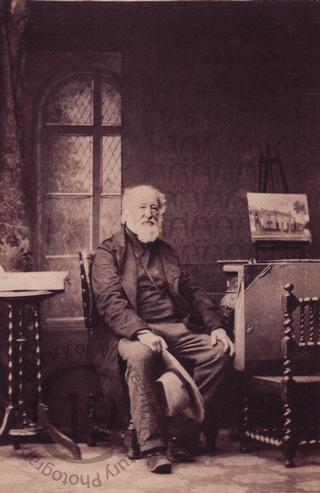
John Linnell
A carte-de-visite portrait of the British artist John Linnell (1792-1882).
The English landscape painter John Linnell was a naturalist and a rival to John Constable. Samuel Palmer was his son-in-law and he was also an associate of William Blake.
A visit to Silvy's studio would have been a nostalgic experience for him, for it was Linnell who had built the house in which Silvy now lived and worked. The following is an extract from The Life of John Linnell, a biography of the artist written by A.T. Story and published in 1892:
'In April, 1828, Linnell removed from Hampstead to Bayswater, at the same time vacating the house which he had kept on as a studio in Cirencester Place. He at first lived at 26, Porchester Terrace, but afterwards he built a house for himself on land leased from the Bishop of London. Into this house -- numbered 38 -- he went to live in 1830. He subsequently added to his lease a plot of land adjoining his house to the south, upon which he built himself a larger studio -- or "workshop," as he preferred to call it -- than the one he had hitherto worked in in the house. He superintended the building operations himself, arranging with, and employing, the various workmen, bricklayers, carpenters, labourers, etc. -- and paying all of them their wages on the Saturday night. The land was leased and the work begun in 1836. The studio was sufficiently finished for him to enter it in the early part of 1837. It was fifty feet long by twenty wide, and was provided with three skylights. Here he used now to paint his portraits with a light from above (as in the case of the portrait of Thomas Carlyle, which was painted in this room).'
Photographed by Camille Silvy of London.
[This sitting does not appear in the Silvy daybooks. Presumably the sitting took place during the period covered by the missing volume, July 1863 to June 1864.]
Code: 124113




